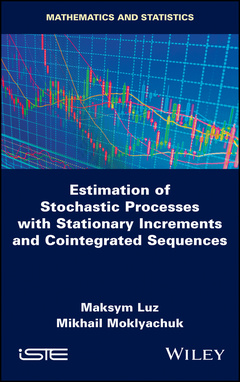Estimation of Stochastic Processes with Stationary Increments and Cointegrated Sequences
Auteurs : Luz Maksym, Moklyachuk Mikhail

Estimation of Stochastic Processes is intended for researchers in the field of econometrics, financial mathematics, statistics or signal processing. This book gives a deep understanding of spectral theory and estimation techniques for stochastic processes with stationary increments. It focuses on the estimation of functionals of unobserved values for stochastic processes with stationary increments, including ARIMA processes, seasonal time series and a class of cointegrated sequences.
Furthermore, this book presents solutions to extrapolation (forecast), interpolation (missed values estimation) and filtering (smoothing) problems based on observations with and without noise, in discrete and continuous time domains. Extending the classical approach applied when the spectral densities of the processes are known, the minimax method of estimation is developed for a case where the spectral information is incomplete and the relations that determine the least favorable spectral densities for the optimal estimations are found.
Notations ix
Introduction xi
Chapter 1. Stationary Increments of Discrete Time Stochastic Processes: Spectral Representation1
Chapter 2. Extrapolation Problem for Stochastic Sequences with Stationary nth Increments 9
2.1. The classical method of extrapolation 9
2.2. Minimax (robust) method of extrapolation 21
2.3. Least favorable spectral density in the class D0f 24
2.4. Least favorable spectral densities which admit factorization in the class D0f 25
2.5. Least favorable spectral density in the class Duv 29
2.6. Least favorable spectral density which admits factorization in the class Duv 29
Chapter 3. Interpolation Problem for Stochastic Sequences with Stationary nth Increments31
3.1. The classical method of interpolation 31
3.2. Minimax method of interpolation 41
3.3. Least favorable spectral densities in the class D−0,n 43
3.4. Least favorable spectral densities in the class D−M,n 47
Chapter 4. Extrapolation Problem for Stochastic Sequences with Stationary nth Increments Based on Observations with Stationary Noise53
4.1. The classical method of extrapolation with noise 53
4.2. Extrapolation of cointegrated stochastic sequences 71
4.3. Minimax (robust) method of extrapolation 75
4.4. Least favorable spectral densities in the class D0f × D0g 80
4.5. Least favorable spectral densities which admit factorization in the class D0f × D0g 82
4.6. Least favorable spectral densities in the class Duv × Dε 84
4.7. Least favorable spectral densities which admit factorization in the class Duv × Dε 86
Chapter 5. Interpolation Problem for Stochastic Sequences with Stationary nth Increments Based on Observations with Stationary Noise89
5.1. The classical method of interpolation with noise 89
5.2. Interpolation of cointegrated stochastic sequences 96
5.3. Minimax (robust) method of interpolation 97
5.4. Least favorable spectral densities in the class D−0,f× D−0,g 100
5.5. Least favorable spectral densities in the class D2ε1× D1ε2 103
Chapter 6. Filtering Problem of Stochastic Sequences with Stationary nth Increments Based on Observations with Stationary Noise107
6.1. The classical method of filtering 107
6.2. Filtering problem for cointegrated stochastic sequences 119
6.3. Minimax (robust) method of filtering 124
6.4. Least favorable spectral densities in the class D0f × D0g 129
6.5. Least favorable spectral densities which admit factorization in the class D0f × D0g 131
6.6. Least favorable spectral densities in the class Duv × Dε 134
6.7. Least favorable spectral densities which admit factorization in the class Duv × Dε 135
Chapter 7. Interpolation Problem for Stochastic Sequences with Stationary nth Increments Observed with Non-stationary Noise139
7.1. The classical interpolation problem in the case of non-stationary noise 140
7.2. Minimax (robust) method of interpolation 148
7.3. Least favorable spectral densities in the class D−0,μ× D−0,μ 150
7.4. Least favorable spectral densities in the class D−M,μ×D−M,μ 153
Chapter 8. Filtering Problem for Stochastic Sequences with Stationary nth Increments Observed with Non-stationary Noise155
8.1. The classical filtering problem in the case of non-stationary noise 156
8.2. Minimax filtering based on observations with non-stationary noise 170
8.3. Least favorable spectral densities in the class D0f × D0g 174
8.4. Least favorable spectral densities which admit factorizations in theclass D0f × D0g 175
8.5. Least favorable spectral densities in the class Duv × Dε 177
8.6. Least favorable spectral densities which admit factorizations in the class Duv × Dε 178
Chapter 9. Stationary Increments of Continuous Time Stochastic Processes: Spectral Representation181
Chapter 10. Extrapolation Problem for Stochastic Processes with Stationary nth Increments187
10.1. Hilbert space projection method of extrapolation 187
10.2. Minimax (robust) method extrapolation 205
10.3. Least favorable spectral densities in the class D0f × D0g 208
10.4. Least favorable spectral density in the class D0f 210
10.5. Least favorable spectral density which admits factorization in the class D0f 211
10.6. Least favorable spectral densities in the class Duv × Dε 213
10.7. Least favorable spectral densities which allow factorization in the class Dδ 215
Chapter 11. Interpolation Problem for Stochastic Processes with Stationary nth Increments217
11.1. Hilbert space projection method of interpolation 217
11.2. Minimax (robust) method of interpolation 226
11.3. Least favorable spectral densities in the class D0f × D0g 229
11.4. Least favorable spectral density in the class D0f 230
11.5. Least favorable spectral densities in the class D01/f × D01/g 231
11.6. Least favorable spectral density in the class D01/f 233
11.7. Least favorable spectral densities in the class Duv × Dε 234
11.8. Least favorable spectral density in the class Duv 235
11.9. Least favorable spectral density in the class D2ε 236
Chapter 12. Filtering Problem for Stochastic Processes with Stationary nth Increments239
12.1. Hilbert space projection method of filtering 239
12.2. Minimax (robust) method of filtering 246
12.3. Least favorable spectral densities in the class D0f × D0g 248
12.4. Least favorable spectral densities in the class Duv × Dε 250
Problems to Solve 253
Appendix 259
References 267
Index 281
Maksym Luz is Deputy Local Chief Actuary and Risk Officer at BNP Paribas Cardif, Ukraine.
Mikhail Moklyachuk is Full Professor at the Department of Probability Theory, Statistics and Actuarial Mathematics, Taras Shevchenko National University of Kyiv, Ukraine.
Date de parution : 12-2019
Ouvrage de 320 p.
16x23.6 cm



